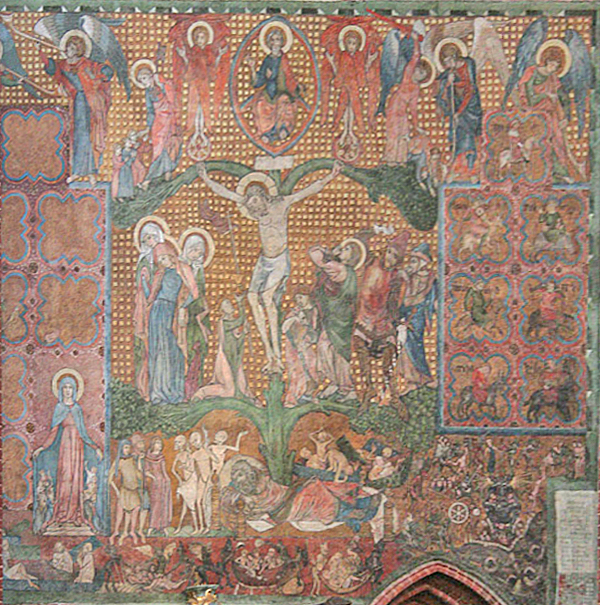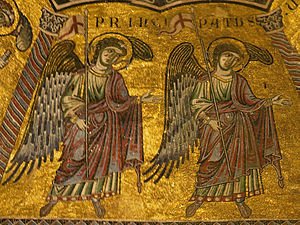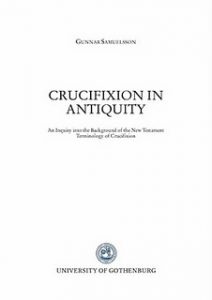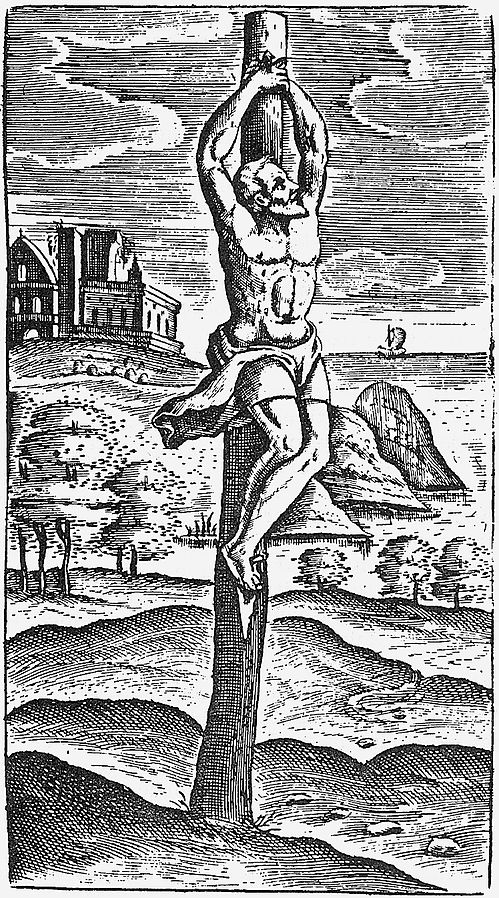Continuing from Reasons, 3 . . .
This post owes almost all of its details to T. E. Schmidt’s Jesus’ Triumphal March to Crucifixion. So if you’ve read that there is no need to read this. I have a few additional points here, but nothing substantial. I only attempt a slightly different perspective, that’s all.
Firstly, I am going to try to avoid using the word “irony” in connection with Mark’s narrative here, since I have recently been alerted to the fact that the literary use of irony is a relative latecomer in the history of literature, and that what authors of Mark’s era were taught and practiced was the good old Aristotelian gradually unfolding “recognition” scenes. These were the stuff of ancient Hellenistic creative literature.
Paul makes the analogy between Christ and the Roman Triumphator plain and direct in 2 Corinthians 2:14-15
Christ always leads us in triumphal procession, and through us spreads in every place the fragrance that comes from knowing him. For we are the aroma of Christ to God among those who are being saved and among those who are perishing.
The Triumphators’ followers were saved, and some of his prisoners were sent off for execution.
The conquering general or emperor was hailed as the epiphany of God. Initially he was the god Dionysus, but later was identified with Zeus. The crowds who came to see this event would repeatedly cry out “Triumpe”, a call for the god to make himself manifest.
The Roman Triumphal March
Mark 15:16
Then the soldiers led him away into the hall called Praetorium, and they called together the whole garrison.
The Praetorium was, in Rome, the common designation for the place and personnel of the imperial guard. It was the imperial guard who made and unmade emperors. (It could also refer to a military HQ in general, but throughout this post I am going to be assuming Mark was written in Rome for a Roman audience.)
The soldiers call for the whole cohort of 200 men minimum. It is unimaginable to think of 200 soldiers being called out to make fun of one man. It appears that Mark is signalling to his readers that Jesus about to embark of a triumphal procession as a sign of his power over all his enemies, and he is doing this by bringing in the props that were used for a Roman emperor’s procession.
Mark 15:17
And they clothed him with purple, and they twisted a crown of thorns, put it on his head,
The Roman emperor wore purple. It was a colour forbidden to lower ranks. Schmidt remarks that in Jerusalem the only purple cloak available for this mockery of Christ would have been Pilate’s, and Pilate is hardly likely to have lent his out for this occasion to be spat on.
Mark instead is signalling to his readers in the know that Jesus is the true imperial conqueror, in particular at this very moment.
The Roman triumphator would be clothed in purple, wear a crown of laurel, and hold a staff in his right hand. Another anomaly here is the notion that there would be right nearby a handy clutch of thorn branches for soldiers to make an impromptu crown. The details are signalling to the reader that this moment of humiliation is in fact the moment of Jesus’ Triumph over his enemies.
Mark 15:18
and began to salute him, “Hail, King of the Jews!”
Before embarking on the triumphal procession the Roman conqueror would stand before his soldiers to receive their adulation. Again, this is the author’s way of adding more detail to verify the truly conquering identity of Jesus, though this is obviously hidden from the actors in the narrative.
Mark 15:20
And when they mocked him . . .
This point is not discussed by Schmidt, but I think it is a significant detail nonetheless. Roman triumphators, even though appearing as a god, would be accompanied in by those whose task it was to mock, ridicule and insult them in their ears — in order to remind them, we are informed, that they were but men. To keep them humble.
Mark 15: 21
Now they compelled a certain man, Simon a Cyrenian, the father of Alexander and Rufus, as he was coming out of the country and passing by, to bear his cross.
The triumphal procession included the sacrificial animal being led by its executioners carrying the double-bladed axe, the instrument of their execution.
Not mentioned by Schmidt, and a detail that is testified (in a historical novel by Heliodorius) a good century after this narrative was written, is that these butchers or executioners of the triumphal sacrifice were taken from the countryside. That was their “craft”, after all — butchering their animals for sale.
Again not mentioned by Schmidt, but I can’t help but wonder about the names Alexander and Rufus in this context. Who was Alexander but the archetypical Greek conqueror, and who is Rufus (meaning Red) but the Roman conqueror in such a procession whose face was painted red in imitation of Zeus for this march. And Simon a Cyrenian, is, of course, the namesake of the Simon who failed Jesus at this moment. Instead of taking up his own cross and following Jesus, he is assisting with the execution of Jesus.
Mark 15:22
And they brought him to the place Golgotha, which is translated, Place of the Skull/Head.
Schmidt explains that a more accurate translation is Head rather than Skull. Citing Schmidt, here:
Mark may be offering this translation simply to heighten the sense of the macabre. But there is a remarkable coincidence in the name of the place that may constitute another allusion to the triumph. Dionysius of Halicarnassus records the legend that, during the laying of a foundation for a temple on a certain Roman hill, a human head was discovered with its features intact. Soothsayers proclaimed:
“Romans, tell your fellow citizens it is ordered by fate that the place in which you found the head shall be the head of all Italy,” (and) since that time the place is called the Capitoline hill from the head that was found there; for the Romans call heads capita.
The temple of Jupiter Capitolinus, or more simply the Capitolium, was the terminus of every Roman triumph. The procession would wind through the streets to the Forum, culminating in the ascent of the triumphator to the place of sacrifice—the place named after a death’s-head. The name “Golgotha” (head) may simply be a linguistic and historical coincidence, but to an audience prepared by the context of Mark’s gospel to look for double meanings, it would be a glaring and meaningful coincidence: Golgotha was the Capitolium (head) to which the triumphator ascended.
I used to disagree with Michael Turton’s suggestion that Mark’s gospel was indicating that Jesus was crucified in or at the Temple. I am not so sure I should disagree any longer. If Mark was writing for a Roman audience, and this is often suggested by scholars, then he gives no reason to think that his readers would picture any scene other than Jesus being crucified at the Jerusalem temple. It is worth recalling that some early Christian texts (e.g. the last part of the Ascension of Isaiah and the Book of Revelation) did indeed say that Jesus was crucified in Jerusalem.
I know the suggestion seems crazy, but surely that is only because of our familiarity with all the paintings of the crucifixion scene — AND because of our convictions that there is an historical basis to this fabulous story. (It would also make a little more sense of the remark that “someone noticed” that the temple veil was torn in two at the moment of Jesus’ death.)
Mark 15:23-24
Then they gave him wine mingled with myrrh to drink, but he did not take it. And when they crucified him. . .
Expensive wine is offered at the moment he is to be sacrificed, but he does not take it. Roman readers familiar with the Roman triumphal procession knew that at the moment of the sacrifice of the bull the emperor was offered wine, which he poured out on the bull itself. The bull was the god dying and the emperor was the god living at this moment of the pouring out of the wine.
Mark 15:27
And with him they crucified two bandits, one on his right and the other on his left.
Roman readers would have recognized this from triumphal processions also — as in the following examples of Triumphs:
- Tiberius took his seat beside Augustus between two consuls
- Claudius in his triumph with his sons-in-law supporting him on either side
- Vitellius placed his conquering generals, Valens and Caecina, on either side of him
- Vespasian rode with his son Titus on one side in his chariot and with his other son, Domition, riding on his other side
Historical or rhetorical?
It ought to be obvious that the original author was not interested in narrating history. Historical reconstruction is not on his agenda. The whole structure is composed of implausibilities and oddities (the fact of the crucifixion itself with Pilate releasing a rebel and crucifying Jesus just to please a crowd, the crown of thorns, cloak of purple, 200 soldiers called out for one man, offering a very expensive wine — not a pain killer — with myrrh; and more is to follow, with noon turning to dark, etc.) that serve to inform insider readers that Jesus was, at this moment of humiliation, undertaking his conquering procession.
And this, note, is the first narrative of the crucifixion after Paul’s many references to it as a theological (only) event.
Like this:
Like Loading...
 Continuing here Nanine Charbonnel’s Jésus-Christ, Sublime Figure de Papier. This post covers pages 398 to 411. I have questions and some doubts about certain connections that are being made in these pages and note NC’s occasional expressions of tentativeness. But I’ll try to present here the key points expressed and from time to time add what I think is an alternative (or additional) rationale for some of the points made. One question raised is whether some of the connections proposed are the results of reflection on the cross rather than inspirations for introducing the cross into theological imagery in the first place.
Continuing here Nanine Charbonnel’s Jésus-Christ, Sublime Figure de Papier. This post covers pages 398 to 411. I have questions and some doubts about certain connections that are being made in these pages and note NC’s occasional expressions of tentativeness. But I’ll try to present here the key points expressed and from time to time add what I think is an alternative (or additional) rationale for some of the points made. One question raised is whether some of the connections proposed are the results of reflection on the cross rather than inspirations for introducing the cross into theological imagery in the first place. Crown of Thorns
Crown of Thorns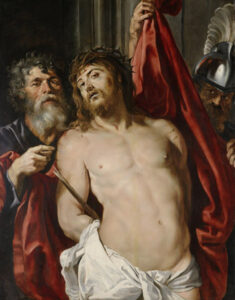 John 19:5 “Behold the man” — with these words Pilate presents Jesus to the crowd. This is the same phrase as the Septuagint (Greek version) uses to present the first king of Israel: ἰδοὺ ὁ ἄνθρωπος — “behold the man” in 1 Samuel 9:17 (Greek text). One may well see here a “subtle” announcement of Jesus as the “king of the Jews”, the words to be placed on the titulus above the cross.
John 19:5 “Behold the man” — with these words Pilate presents Jesus to the crowd. This is the same phrase as the Septuagint (Greek version) uses to present the first king of Israel: ἰδοὺ ὁ ἄνθρωπος — “behold the man” in 1 Samuel 9:17 (Greek text). One may well see here a “subtle” announcement of Jesus as the “king of the Jews”, the words to be placed on the titulus above the cross.
